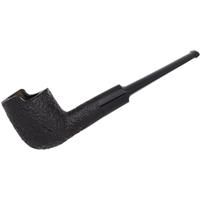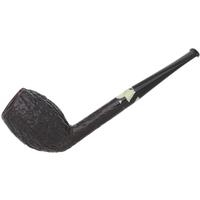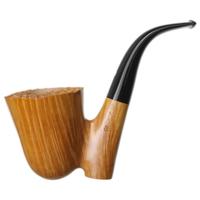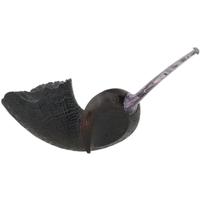I have been seeing pipes with Bakelite stems. Ashton is using this material of construction. Are there any opinions out there? How does this compare to acrylic or vulcanite?
Bakelite Stems?
- Thread starter stanlaurel
- Start date
- Status
- Not open for further replies.
I have an Askwith that supposedly has a white Bakelite stem. I have doubts that's what it is. Or it's a newer softer formula. It feels softer then acrylic, but not as hard as I think Bakelite should. The old Bakelite stems are similar to the feel of glass. It's hard. It took a while for me to get used to them. Now I prefer old pipes with Bakelite stems. But it has to be a wide bit with a good button. The slim ones feel like a glass thermometer in the mouth. Hard to clench.
There was recently a good discussion of Bakelite stems elsewhere. I wonder if the Ashton Bakelite stems are of the variety that dissolves in alcohol. If they are, then giving the pipes a good cleaning will be more difficult.
Here is a link (the article appears to be a translation) that came up in that discussion:
http://www.lformula.com/index.php?part=him007&page=029
Here is a link (the article appears to be a translation) that came up in that discussion:
http://www.lformula.com/index.php?part=him007&page=029
I have one very old pipe with a Redmanol stem (Bakelite) and I'd never clench it as it is harder than a rock. I believe it's a very poor stem material and I'm not sure where the connection is being made to Ashton. Bill Taylor used Ashtonite and Jimmy Craig is using vulcanite to the best of my knowledge.
OK, splitting hairs. It darkens with age, but doesn't turn yellow from the sulphur like vulcanite, which is what pipe people mean when they refer to stems oxidizing.
Yeah, I have pipes 100 years old with ruby red Bakelite stems that are still ruby red. There are some amber versions from that period that are a bit softer. And there are later formulations that feel and react a bit differently. But historically, Bakelite is pretty much gone on pipe stems by the '50s in favor of nylon and later acrylic. The Ashton white stems are supposedly 1930s Bakelite. But I've never seen a 1930s pipe with a white Bakelite stem. I'm not sure what all that means. But I'm skeptical without knowing more about the provenance of the material.OK, splitting hairs. It darkens with age, but doesn't turn yellow from the sulphur like vulcanite, which is what pipe people mean when they refer to stems oxidizing.
That says Bakelite. But it looks like modern acrylic to me. In my mind Acrylic and Bakelite, though both are technically plastic, are very different materials. Seems like the terms are being used interchangeably.Right here on pipes2smoke.
I am confused and crave enlightenment. :?
Bakelite is the Bain of my existence closely followed by Amberlite and worse still Amber-ite. The ruby red stems seem to survive quite well for some unexplained reason but the stuff often described as amber on the Oi Vay auction site is usually turn of the century dross. I usually have all my pipes restemmed as soon as I get them as it saves both time and grief later on in the process. Actually some of the material used to make false amber stems in the 19th century are quite dangerous and possibly cancer causing and is best treated with extreme caution.
This pipe looks like it has a Bakelite stem. Coopersark says he procured the rod stock and sent it to Ashton. I guess he is satisfied with the provenance of the material.
http://www.ebay.com/itm/Ashton-XX-Pebble-Grain-Ring-Grain-Prince-Pipe-w-Rare-1930s-Bakelite-New-/391182205136?pt=LH_DefaultDomain_0&hash=item5b1446c0d0
http://www.ebay.com/itm/Ashton-XX-Pebble-Grain-Ring-Grain-Prince-Pipe-w-Rare-1930s-Bakelite-New-/391182205136?pt=LH_DefaultDomain_0&hash=item5b1446c0d0
I do agree that bakelite does oxidize but in my, admitedly, limited experience it's a very slight oxidation even on +/- 100 year old pipes. I only have a few of these but all of them had just a hair of oxidation when I polished the stems. Nothing even in the same universe as a vulcanite stem but it was there. Now as far as it being a vastly different color once the oxi was cleaned off, that hasn't been my experience. The difference was noticable but not drastic.Bakelite actually DOES oxidize, albeit slowly. It is common for pipemakers to come upon bakelite rods that are one color and a totally different one once cut into.
I remember a while back seeing a Dunhill with bakelite stem (or some unknown substance?),
it was originally stark white but over time had turned a warm buttery color...
http://pipesmagazine.com/forums/topic/modern-dunhill-with-bakelite-stem
: :
:
Here's a fun fact,
yes, at one time they made just about everything from bakelite...

...but did you know they even made coffins from the stuff???

Patrick Cook of the Bakelite Museum is the proud possessor of two examples, one for his collection and one to be buried in.
http://www.dailymail.co.uk/mailonsunday/article-1082316/Plastic-fantastic-The-pre-war-Bakelite-auction-expected-raise-thousands.html
it was originally stark white but over time had turned a warm buttery color...
http://pipesmagazine.com/forums/topic/modern-dunhill-with-bakelite-stem
:
 :
:Here's a fun fact,
yes, at one time they made just about everything from bakelite...

...but did you know they even made coffins from the stuff???

Patrick Cook of the Bakelite Museum is the proud possessor of two examples, one for his collection and one to be buried in.
http://www.dailymail.co.uk/mailonsunday/article-1082316/Plastic-fantastic-The-pre-war-Bakelite-auction-expected-raise-thousands.html
This unusual coffin is believed to be the largest phenolic moulding made in the UK. It was designed by James Doleman and made by Ultralite Casket Co Limited. The coffin was manufactured from imitation walnut phenolic resin with a wood flour filler devised by the Bakelite Company Ltd of London. The coffin did not go into large scale production, partly because of the inventor’s death in 1944 during the Second World War. This example was recovered from the Tyseley factory of Bakelite UK, near Birmingham, in 1985. The first synthetic thermosetting plastic was phenol formaldehyde. It was patented in 1909 by Belgian-born chemist Leo Baekeland (1863-1944) who had emigrated to the US in 1889. The substance forms a useful mouldable plastic when combined with a wood flour filler. It is known by its trade name ’Bakelite’, after its inventor.
"yes, at one time they made just about everything from bakelite..."
Except when they were made from Catalin, a competing thermosetting compound (in this case a polymer) which was invented in 1927 by the American Catalin Corporation. My guess is that at least some of the radio housings shown could be Catalin.
Except when they were made from Catalin, a competing thermosetting compound (in this case a polymer) which was invented in 1927 by the American Catalin Corporation. My guess is that at least some of the radio housings shown could be Catalin.
That is interesting, and certainly possible. I only have three old WDCs so my body of experience with bakelite certainly isn't extensive.So it's a very real phenomenon for bakelite to oxidize as quickly or even more quickly than vulcanite, but I think it's an intriguing natural aspect of the material.
It is interesting stuff with an interesting history. Seems like there was a period of time when a lot of things were called bakelite that weren't. I wonder how many pipes were sold with "bakelite" stems that were a different plastic all together. Definitely would muddy the waters. And who knows if pipemakers were even sure which material they were actually selling. It's like generically calling all cotton swabs q-tips kind of.
When I was trying to research my "Redmanol" pipe I found some documents concerning a major lawsuit against the use of the word since Bakelite was supposedly granted a patent first of some such thing. The Redmanol stem I have us ruby red and has zero oxidation. I was completely surprised to see that Ashton with the Bakelite stem, never knew it was used by Ashton. One thing for sure though, the stuff is not comforatable compared to any other stem material I've had experience with.
I have one. It is not so good in the teeth, and I read somewhere about it possibly being carcinogenic. I do not smoke it, will replace it with ebonite one day.
I've had a couple catalin stem pipes. It's identifiable by being heavier than Bakelite. Proportionate to it's size, it has weight more akin to stone. The only color I've seen for catalin stems is yellow. And the color is surface deep. Trying to work toothmarks takes the color off. This is true of some Bakelite stems as well. But less so.Except when they were made from Catalin, a competing thermosetting compound (in this case a polymer) which was invented in 1927 by the American Catalin Corporation. My guess is that at least some of the radio housings shown could be Catalin.
Catalin stem:

- Status
- Not open for further replies.












